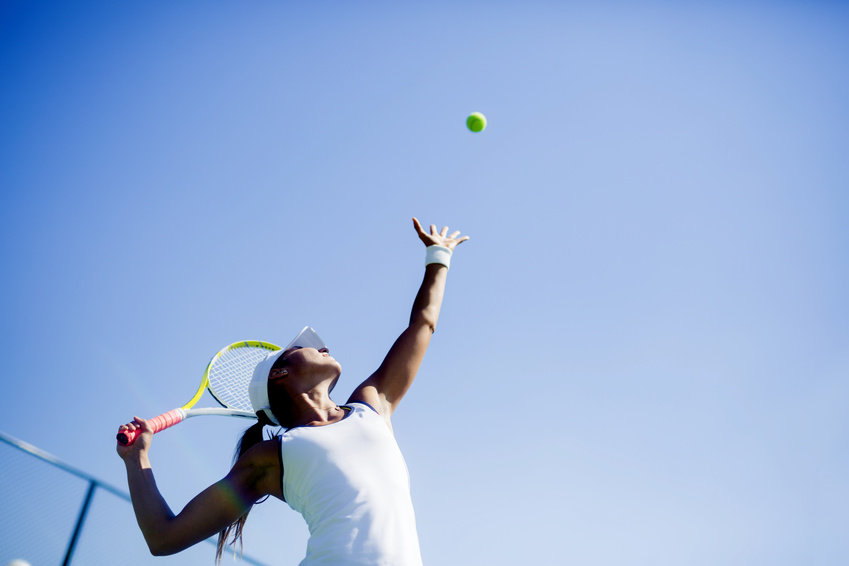Tennis requires power, agility, on-court endurance, and flexibility. A strength and mobility program will undoubtedly set a tennis athlete up for success. Proper nutrition fuels the athlete to meet those physical demands. Athletes must recognize that a holistic approach is vital in order to compete at a high level.
1. Nutrition & Hydration
Tennis athletes utilize both anaerobic and aerobic energy systems due to the stop-and- go nature of the sport. Fueling strategies need to reflect the explosiveness and endurance demands. Because tennis is typically played in warmer temperatures, hydration is essential. According to the NCAA Sport Science Institute, “Tennis athletes can lose up to 5 or 6 pounds of sweat per hour, with each pound of sweat containing about 500 milligrams of sodium.” Replenishment of electrolytes and proper hydration not only decreases the potential for muscle cramping, but it also helps an athlete’s focus on court which allows for greater consistency with stroke mechanics.
2. Proper Warm Up/Cool Down:
A warm up and a cool down are components of the sport that are often overlooked. The purpose of a warm up is to prepare the body for the physical demands that occur during a tennis match such as cutting, sprinting, and sudden stopping. Hitting volleys and groundstrokes with a teammate is a great way to get into a rhythm, but warm ups should also include some form of light aerobic activity and dynamic stretching to prepare your body before you even begin to hit. Dynamic stretching (taking the muscle through a challenging range of motion in a cyclic manner) is preferred over static stretching (holding a muscle or a joint in a sustained position over a period of time) because it leads to increased core temperature and may even improve performance. In fact, athletes should avoid static stretching as it reduces muscle strength for up to 30 minutes secondary to neural and mechanical factors. Skipping the warm up is not an option among competitive tennis players because it may result in otherwise preventable injuries. Following an athletic event, static stretching can be utilized to improve flexibility and cool down the body by lowering the heart rate to bring the body back to homeostasis. Both warm-ups and cool-downs should take roughly ten minutes.
Check out these videos to help formulate exercises for warm-ups and cool-downs: https://www.youtube.com/watch?v=TtFvH11bgVk
https://www.youtube.com/watch?v=Fes0KbM9700
3. Mobility
Dr. Kelly Starrett, founder of MobilityWOD.com, states, “Mobilization is a tool for improving one’s capacity to move and perform efficiently.” The elements in the human body that might interfere with optimal performance may include tight muscles, joint capsule and soft tissue restrictions, motor control problems, and neural dynamic issues (Starrett, 2015). Restricted mobility results from faulty movement patterns or poor static body positions like slouched sitting. Consider a tennis player who does not experience shoulder pain when serving until the second set. This athlete may not demonstrate capsular and muscular restrictions in his or her shoulder, so mobilizing the shoulder may relieve pain temporarily, but it does not fix to the long term problem. This athlete is limited from a movement pattern perspective. Correcting mechanical errors during the tennis serve is the first part. The second is to ensure that there is enough neuromuscular control through the shoulder and scapulothoracic region. When an athlete is lacking mobility and efficient movement patterns, it is an invitation for injury to happen. Mobility is an essential component of good training programs.
Here are some tennis related mobility exercises: https://www.youtube.com/watch?v=ItkLE_ulCtE
4. Resistance Training
Tennis athletes undergo a lot of repetitive stress on their muscles and joints while serving and hitting groundstrokes. Practicing serves and groundstrokes often will make you a good, consistent player, but to reach your maximal potential, get started on a strength training program. And by strength training, that doesn’t mean you need to lift two times your body weight – save that for the defensive lineman. In fact, weights may not be
used at all. Many resistance training exercises may utilize your bodyweight alone in combination with bands and plyometric balls. Besides the obvious benefit of striking the ball with more power, strength training will also help the athlete improve speed and endurance. Resistance training strengthens motor control pathways which in turn enhances stroke mechanics. Tennis players should be addressing core, ankle, hip, scapulothoracic, and
rotator cuff strengthening to help control the body before, during, and after a shot is hit. Remember the example above of the athlete experiencing shoulder pain during the second set? The second component mentioned previously to decrease this athlete’s shoulder pain is accomplished through resistance training. Musculoskeletal dysfunction and/or pain are generally accompanied by muscle imbalances. Proximal shoulder strength and endurance are vital to allow the shoulder girdle to remain stable throughout the match. This is just one example of where muscle imbalances can occur in the body.
Here are some tips for resistance exercises and stability training: https://www.youtube.com/watch?v=GkBuOAmYZSE
Resources:
Behm, D. G., Blazevich, A. J., Kay, A. D., & Mchugh, M. (2016). Acute effects of muscle stretching on physical performance, range of motion, and injury incidence in healthy active individuals: A systematic review. Appl. Physiol. Nutr. Metab. Applied Physiology, Nutrition, and Metabolism, 41(1), 1-11.
NCAA Sport Science Institute. Nutrition for the tennis student-athlete. Starrett, K. (2015). Becoming a supple leopard: the ultimate guide to resolving pain, preventing injury, and optimizing athletic performance. Auberry: Victory Belt.

